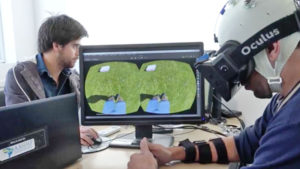 [Philip Lelyveld comment: they use VR to visualize the movement before strapping the subject into the exoskeleton.]
[Philip Lelyveld comment: they use VR to visualize the movement before strapping the subject into the exoskeleton.]
The system and its resulting experiments, conducted by Duke Universityneuroscientist Miguel Nicolelis and his colleagues, was successful in opening up partial restoration of muscle control and sensations in patients's lower limbs. This was possible after the patients were put through an aggressive training regiment with brain-controlled robotics and VR technology.
Virtual reality assisted patients with visualizing the brain-controlled movements and mind-body awareness. With a representation of their own bodies they were able to better make a connection between VR and their physical beings...
Patients regained varying amounts of sensation, ranging from some feeling and muscle control to an astonishing ability to move in a 32-year-old woman who had been paralyzed for 13 years.
See the full story here: https://www.engadget.com/2016/08/12/virtual-reality-paralyzed-patients/